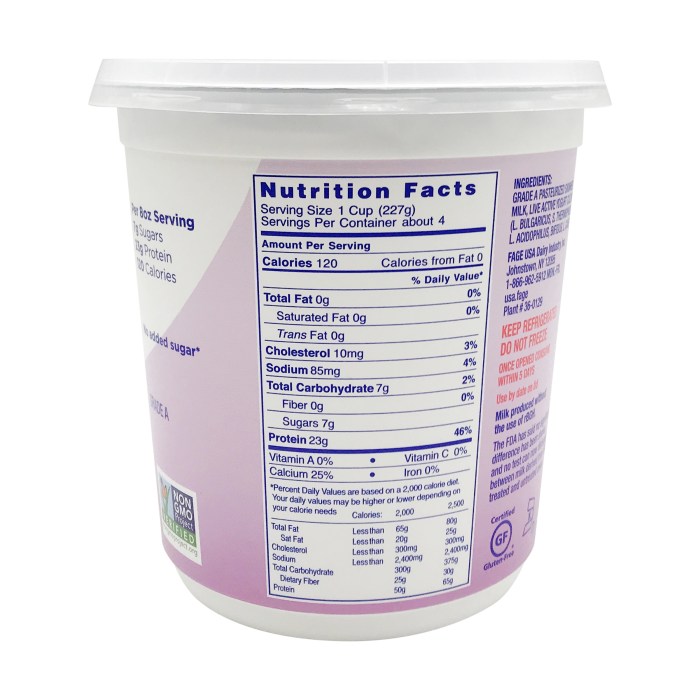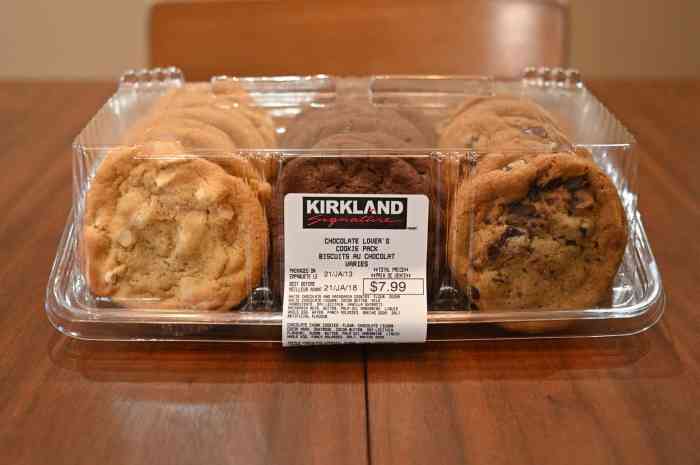Ingredient Analysis

Fage plain yogurt 5 nutrition facts – Fage Total 0% Plain Yogurt’s ingredient list, while seemingly simple, reveals much about its nutritional profile and manufacturing process. Understanding the role of each component allows for a more informed assessment of its suitability within a balanced diet. The relatively short list compared to some commercially available yogurts suggests a focus on minimal processing and core ingredients.The primary ingredients contribute significantly to the overall nutritional value and texture of the yogurt.
Variations in these ingredients, even slight ones, can impact the final product’s taste, consistency, and nutritional content. Comparing Fage’s ingredient list to competitors highlights differences in processing techniques and the prioritization of specific nutritional aspects.
Primary Ingredients and Their Functions
The primary ingredients of Fage Plain Yogurt 5% are milk and active yogurt cultures. Milk provides the base protein, calcium, and fat content (in this case, 5%). The active yogurt cultures, typically strains of
- Lactobacillus bulgaricus* and
- Streptococcus thermophilus*, are essential for fermentation. This fermentation process thickens the yogurt, produces lactic acid (contributing to the tangy flavor), and also contributes to the yogurt’s probiotic properties. These cultures also impact the overall digestibility and potential health benefits associated with yogurt consumption.
- Milk: Provides protein, calcium, fat (5% in this case), and carbohydrates (lactose). The fat content significantly influences the caloric density and creamy texture.
- Active Yogurt Cultures (e.g.,
-Lactobacillus bulgaricus*,
-Streptococcus thermophilus*): These live and active cultures are responsible for the fermentation process, which results in the characteristic tangy flavor and thick consistency. They also contribute to the probiotic properties of the yogurt, supporting gut health.
Comparison to Similar Products, Fage plain yogurt 5 nutrition facts
Compared to other plain yogurts, Fage 5% often features a simpler ingredient list. Many brands include added thickeners, stabilizers, and sweeteners. Fage’s focus on milk and active cultures results in a cleaner nutritional profile, appealing to consumers seeking less processed options. However, this simplicity might mean a slightly less smooth or creamy texture compared to yogurts with added ingredients.
The absence of added sugars is a key differentiator, making it suitable for those watching their sugar intake. Some competitor yogurts might contain fruit purees or other flavorings, impacting the overall nutritional composition and caloric count.
Fage plain yogurt’s nutritional profile boasts high protein and calcium, making it a popular choice for health-conscious individuals. However, comparing its nutritional content to other popular beverages can be insightful; for instance, a look at the coke zero nutrition facts reveals a stark contrast in terms of sugar and calorie content. Returning to Fage yogurt, its relatively low sugar and fat content make it a healthier alternative, especially when considering the overall impact on one’s diet.
Packaging and Labeling Information: Fage Plain Yogurt 5 Nutrition Facts

Fage Total 0% Plain Greek Yogurt, like other food products, relies heavily on its packaging and labeling to convey crucial information to consumers. This information is not merely decorative; it’s legally mandated and essential for informed purchasing decisions and safe consumption. Understanding the components of this labeling is key to making healthy choices and utilizing the product effectively.The information provided on Fage Plain Yogurt 5% packaging is designed to be clear, concise, and informative.
It adheres to regulations ensuring transparency and allowing consumers to make informed choices about their diet. This includes details regarding the product’s nutritional content, ingredients, and storage instructions. The prominence and clarity of this information are critical for consumer trust and brand reputation.
Packaging Label Components and Their Significance
A typical Fage Plain Yogurt 5% label would include several key sections. Firstly, the brand name and product name (“Fage Total 5% Plain Greek Yogurt,” for example) would be prominently displayed, usually alongside a visually appealing image of the yogurt itself. Below this, the net weight (e.g., 170g, 5.7 oz) would be clearly stated, along with any relevant size variations.
This is followed by the nutritional information panel, a critical component mandated by regulatory bodies. This panel usually details the serving size (e.g., 170g), the number of servings per container, and the amount of calories, total fat, saturated fat, cholesterol, sodium, total carbohydrate, dietary fiber, sugars, and protein per serving. The percentage of Daily Value (%DV) for each nutrient is also typically included, offering context for how the yogurt contributes to a daily dietary intake.
Finally, a list of ingredients, ordered from highest to lowest weight, will be present, allowing consumers to assess the product’s composition. Allergen information, such as warnings for milk (a key ingredient in yogurt), would also be prominently featured, often in bold text or a different color to increase visibility. Expiration dates and storage instructions (e.g., “Refrigerate”) complete the label, ensuring product safety and quality.
The packaging itself might also include marketing claims, such as “High in Protein” or “Made with real milk,” but these claims are usually subject to specific regulatory guidelines to prevent misleading advertising.
Understanding Serving Sizes and Nutritional Labels
Understanding serving sizes is crucial for accurately interpreting nutritional information. The nutritional values listed on the label are based on the specified serving size. Consuming more or less than the stated serving will directly impact the total nutrient intake. For example, if the label states that one serving (170g) contains 150 calories, consuming two servings (340g) will result in an intake of 300 calories.
Similarly, the %DV values are calculated based on the serving size, providing a relative measure of the nutrient’s contribution to the recommended daily intake. Careful attention to serving sizes ensures accurate calorie and nutrient tracking, crucial for managing weight and overall health. Misinterpreting serving sizes can lead to inaccurate estimations of daily caloric and nutrient consumption.
Mock-up of Fage Plain Yogurt 5% Packaging Label
Imagine a white rectangular container. At the top, the Fage logo is prominently displayed, followed by “Total 5% Plain Greek Yogurt” in a large, clear font. Below, a picture of creamy, thick yogurt is shown. The net weight (170g / 5.7 oz) is clearly visible near the bottom. A section dedicated to the nutritional information panel provides details in a table format, with columns for nutrient name, amount per serving (170g), and %DV.
Ingredients are listed below, starting with “Milk,” then “Live and Active Cultures,” and so on. A small section provides allergen information (“Contains: Milk”). Finally, the expiration date and storage instructions (“Refrigerate”) are clearly marked at the bottom. This mock-up emphasizes the importance of clear and concise labeling for consumer understanding and informed decision-making.
Detailed FAQs
Is Fage Plain Yogurt 5% suitable for lactose-intolerant individuals?
While Fage Plain Yogurt 5% contains lactose, the amount may vary depending on individual tolerance. Some lactose-intolerant individuals might find they can consume small portions without significant digestive issues. However, individuals with severe lactose intolerance should exercise caution or consider lactose-free alternatives.
How does the protein content in Fage Plain Yogurt 5% compare to Greek yogurt with different fat percentages?
The protein content can vary slightly between different fat percentages of Greek yogurt, including Fage brands. Generally, higher-fat versions may have slightly less protein per serving than lower-fat options, but the difference is often minimal. Check the nutrition label for specific values.
Does Fage Plain Yogurt 5% contain added sugars?
Plain Fage yogurt typically does not contain added sugars. However, always check the nutrition label to ensure no added sugars are present, as variations may exist across different product lines or regional availability.
Where can I find Fage Plain Yogurt 5%?
Fage Plain Yogurt 5% is widely available in most supermarkets and grocery stores in the dairy section. You can also check online retailers for purchasing options.









